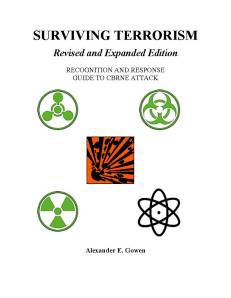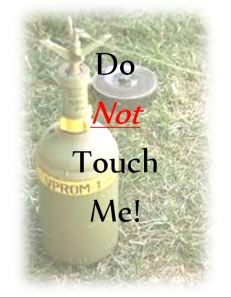A Little Information about the Nerve Agent Sarin (GB)
April 26, 2013
As you may have heard, it has been speculated that the Syrian government has employed the use of Sarin gas (also known as GB) to quash the on-going civil strife in that country. Sarin gas is a highly toxic nerve agent similar to VX and can kill within seconds by attacking the body’s “off switch” for both glands and muscle, causing continuous stimulation until they cease functioning. It is a colorless and tasteless liquid which may have a slightly fruity odor, and is delivered as a vapor during an attack. Sarin was developed by the Germans in 1938 as a pesticide and was used in 1988 by the Iraqis against the Kurdish city of Halabja; in 1994 by the Aum Shinrikyo sect on a subway in Matsumoto and again in 1995 on a subway in Tokyo, Japan; in 2004 by Iraqi insurgents against US troops; and (possibly) in 2012/13 by Syrian military against rebel forces.
Below is the Sarin/Cyclosarin section of my book, Surviving Terrorism. Once again, the text did not transfer well from the book – my apologies.
Sarin (GB) and Cyclosarin (GF)
(Since GB and GF have the same health effects they will be discussed as one in this section)
What is sarin
• Sarin and cyclosarin are human-made chemical warfare agents classified as a nerve agents and are both essentially the same in their effect. Nerve agents are the most toxic and rapidly acting of the known chemical warfare agents. They are similar to certain kinds of pesticides called organophosphates in terms of how they work and what kind of harmful effects they cause. However, nerve agents are much more potent then organophosphate pesticides.
• Sarin originally was developed in 1938 in Germany as a pesticide. The name sarin is comes from the names of the chemists involved in its creation: Schrader, Ambros, Rudriger, and Van der Linde.
• Sarin is a clear, colorless, and tasteless liquid that has no odor in its pure form.
• Sarin may have a slightly fruity odor.
• Sarin can evaporate into a vapor (gas) and spread into the environment.
• Sarin is also known as “GB.”
• Cyclosarin was developed in Germany in 1949.
• Cyclosarin is a clear, colorless, and tasteless liquid.
• Cyclosarin may have a sweet odor like peaches.
• Cyclosarin evaporates 20 times longer than water to evaporate, making it a long-term hazard.
• Cyclosarin is also known as “GF.”
• Both sarin and cyclosarin are easy to create making them a likely terrorist agent.
• The “G” in any G-agent supposedly stands for “Germany” wherein they were developed.
Where sarin is found and how it is used
• Sarin and other nerve agents may have been used in chemical warfare during the Iran-Iraq War in the 1980s.
• Sarin was used in two terrorists attacks in Japan in 1994 and 1995.
• Sarin is not found naturally in the environment.
What happens to sarin when released into the environment
• When released into the air, sarin will be broken down by compounds that are found in the air, but may persist for a period of one day up to a few days before being broken down.
• Sarin will be broken down in water quickly, typically within 1 week, but small amounts may evaporate.
• Sarin will be broken down in moist soil, typically within 1 to 5 days. Small amounts may evaporate into the air or travel below the soil surface and contaminate ground water.
• Sarin will not accumulate in the food chain.
• Cyclosarin evaporates 20 times longer than water so it will persist in the environment for weeks.
How people can be exposed to sarin
• Following release of sarin into the air, people can be exposed through skin contact, eye contact, or inhalation (breathing in sarin).
• Sarin mixes easily with water, so it could be used to poison water. Following release of sarin into water, touching or drinking water that contains sarin can expose people.
• Following contamination of food with sarin, eating the contaminated food can expose people.
• A person’s clothing can release sarin for about 30 minutes (or longer in the case of cyclosarin) after it has come into contact with sarin vapor, which can lead to exposure of other people.
• Because sarin breaks down slowly in the body, people who are repeatedly exposed to sarin may suffer more harmful effects.
• Because sarin vapor is heavier than air, it will sink to low-lying areas and create a greater exposure hazard there.
How sarin works
• The extent of poisoning caused by sarin depends on the amount of sarin to which a person was exposed, how the person was exposed, and the length of time of the exposure.
• Symptoms will appear within a few seconds after exposure to the vapor form of sarin and within a few minutes up to 18 hours after exposure to the liquid form.
• The effects of sarin last longer than other nerve agents and can cause injury and death days later because of its viscosity.
• All the nerve agents cause their toxic effects by preventing the proper operation of the chemical that acts as the body’s “off switch” for glands and muscles. Without an “off switch,” the glands and muscles are constantly being stimulated. They may tire and no longer be able to sustain breathing and heart functions.
• Sarin is the most volatile of the nerve agents, which means that it can easily and quickly evaporate from a liquid into a vapor and spread into the environment. People can be exposed to the vapor even if they do not come into contact with the liquid form of sarin.
• Because it evaporates so quickly, sarin presents an immediate but short-lived threat.
Immediate signs and symptoms of sarin exposure
• People may not know that they were exposed because sarin has no odor.
• People exposed to a low or moderate dose of sarin by breathing contaminated air, eating contaminated food, drinking contaminated water, or touching contaminated surfaces may experience some or all of the following symptoms within seconds to hours of exposure:
- Runny nose
- Watery eyes
- Small, pinpoint pupils
- Eye pain
- Blurred vision
- Drooling and excessive sweating
- Cough
- Chest tightness
- Rapid breathing
- Diarrhea
- Increased urination
- Confusion
- Drowsiness
- Weakness
- Headache
- Nausea, vomiting, and/or abdominal pain
- Slow or fast heart rate
- Low or high blood pressure
• Even a small drop of sarin on the skin can cause sweating and muscle twitching where the sarin touched the skin.
• Exposure to large doses of sarin by any route may result in the following harmful effects:
- Loss of consciousness
- Convulsions
- Paralysis
- Respiratory failure leading to death
• Showing these signs and symptoms does not necessarily mean that a person has been exposed to sarin.
How people can protect themselves, and what they should do if they are exposed to sarin
• Recovery from sarin exposure is possible with treatment, but the antidotes available must be used quickly to be effective. Therefore, the best thing to do is avoid exposure.
• Leave the area where the sarin was released and get to fresh air. Quickly moving to an area where fresh air is available is highly effective in reducing the possibility of death from exposure to sarin vapor.
- If the sarin release was outdoors, move away from the area where the sarin was released.
- Go to the highest ground possible, because sarin is heavier than air and will sink to low-lying areas.
- If the sarin release was indoors, get out of the building.
• If people think they may have been exposed, they should remove their clothing, rapidly wash their entire body with soap and water, and get medical care as quickly as possible.
• Remove and dispose of clothing:
- Quickly take off clothing that has liquid sarin on it. Any clothing that has to be pulled over the head should be cut off instead. If possible, seal the clothing in a plastic bag. Then seal the first plastic bag inside a second plastic bag. Removing and sealing the clothing in this way will help protect people from any chemicals that might be on their clothes.
- If clothes were placed in plastic bags, inform either the local or state health department or emergency personnel upon their arrival. Do not handle the plastic bags.
- If helping other people remove their clothing, try to avoid touching any contaminated areas, and remove the clothing as quickly as possible.
• Wash body thoroughly:
- As quickly as possible, wash any liquid sarin from the skin with large amounts of soap and water. Washing with soap and water will help protect people from any chemicals on their bodies.
- Rinse eyes with plain water for 10 to 15 minutes if they are burning or if vision is blurred. If you wear contacts, remove them before rinsing your eyes, and place them in the bags with the contaminated clothing.
- Do not put contacts back in your eyes. You should dispose of them even if you do not wear disposable contacts. If you wear eyeglasses, wash them with soap and water. You can put the eyeglasses back on after you wash them.
• Do not induce vomiting or drink fluids if sarin has been swallowed.
• Seek medical attention immediately. Dial 911 and explain what has happened.
How sarin is treated
Treatment consists of removing sarin from the body as soon as possible and providing supportive medical care in a hospital setting. Antidotes are available for sarin. They are most useful if given as soon as possible after exposure.
Assume the Worst – Be Prepared
April 26, 2013
During a terrorist incident such as the one we just endured in Boston, MA, you must always assume that the event is on-going. Once an attack begins, evacuate the area as quickly as possible. Help guide confused civilians away from the scene as you proceed to a safety. If you are alone and have first aid experience, provide medical assistance to injured individuals until a medical team arrives. Once you have evacuated the incident area, do not assume that you are safe. The attack may focus on other targets. Avoid mass-transit systems such as subways, buses, and trains. If you are able to access your car, avoid bridges and tunnels.
Other cities may experience simultaneous events just as we did on 9/11. The attacks will most likely utilize the same weapon/s, so be prepared. If you live in a major metropolitan area it would be wise to evacuate high-capacity buildings including athletic arenas and other crowded areas. Get home as quickly as possible and plan to stay in place until it is certain that the event is over.
Remember, the best way to survive a terrorist attack is to be prepared:
- Learn how to identify potential targets.
- Study CBRNE weapons and memorize their appearance as well as any signs and symptoms.
- Plan primary, secondary, and tertiary escape routes for you and your family/friends.
- Give your children identification cards to show to authorities should they get separated.
- Determine a point of assembly for your family/friends should an attack occur.
- If an attack involves chemical, biological, or radioactive weapons, button and/or zip up clothes, cover your mouth with a cloth, and leave the scene immediately. Follow signs or instructions to the nearest decontamination facility. Remember, everything you are wearing will be confiscated due to contamination, so it might be good practice to leave anything of value at home when going to high-risk areas. If there are no decontamination facilities, go home and immediately discard all items you wore into a garbage bag and seal completely. This includes eye wear, jewelry, etc, as they may be contaminated.
- If you have any information about the event, be sure to share your knowledge with the authorities – your assistance may help save lives.
“Surviving Terrorism: Recognition and Response Guide to CBRNE Attack” Now Available at Amazon.Com
April 23, 2013
The revised and expanded version of Surviving Terrorism is now available at Amazon.Com. Just look up Surviving Terrorism: Recognition and Response Guide to CBRNE Attack and it will take you directly to my page. Individual copies are 29.99. Please contact me directly for mass or institutional purchases.
My Thoughts on the Boston Bombings – by Alex Gowen
April 23, 2013

Police officers guard the entrance to Franklin Street in the Watertown, Mass. neighborhood where Boston Marathon bombing suspect Dzhokhar Tsarnaev was captured. The 19-year-old college student wanted in the bombings was taken into custody Friday evening after a manhunt that left the city virtually paralyzed and his older brother and accomplice dead. (AP Photo/Matt Rourke)
Details are slow to come from authorities about exactly what explosive material was used by the Tsarnaev brothers. My analysis of the photos of the explosions leads me to believe that something as simple as gunpowder may be the culprit. That being said, the IEDs were powerful and extremely damaging, and caused a great deal of bodily harm to our citizens. This act of terror must be analyzed thoroughly so that we will be better prepared for future acts of aggression against the United States.
Here is what we know:
1) The bombers detonated two IEDs.
2) Pressure cookers were used as bomb casings.
3) Both IEDs contained BBs/ball bearings and carpenter nails to increase bodily injury.
4) A simple timing device was employed to detonate the IEDs.
5) Execution of the attack was well-coordinated but poorly-planned.
6) The IEDs were crudely-made and did not have the hallmarks of a well-trained expert.
7) The recipe for the IEDs is easily found on the internet.
8) Despite the presence of many cameras, security, and civilians, no one noticed either brother placing their IED prior to the event.
I’ve seen footage of pressure-cooker bombs being detonated and they are quite deadly. They are also simple in construct, safe to transport, and made out of ordinary materials which no one would suspect may be turned into an IED. When I was a child I used to make my own fireworks because I was young, dumb, and curious. If I, as 13 year-old with no access to the internet, could create explosives out of common household items, just image what can be done by well-funded experts. That being said, remember that you don’t need a hydrogen bomb to terrorize the people – all you need is one person with one pipe bomb at a crowded public location. Unsophisticated devices are easy to make, hard to identify as a potential threat, and are capable of tremendous loss of life.
We Americans need to realize that we’re an easy target. Rather than limit our freedoms, however, we need to focus on awareness. Law enforcement authorities know what to look for, but they cannot be everywhere all the time. We – the American citizenry – must be vigilant. We must keep a sharp eye and assist our brothers in blue by reporting suspicious activity and/or items. In order to do so, we need to be informed. Read any credible guide on CBRNE weapons so that you are aware of potential dangers. The more eyes we have on the street, the safer we will be. Let us no longer be an easy target. Protect our nation and join the fight rather than be a bystander. Do not be a victim – become America’s modern Minutemen and take part in eliminating terrorism as a domestic threat.
A Little Information About Ricin
April 18, 2013
As you may have heard, letters indicating the presence of the biological toxin ricin were mailed to both President Obama and Senator Roger Wicker of Mississippi on April 16 and 17. Ricin is a very powerful poison created from castor seeds, is relatively easy to make, is most deadly when inhaled, and can kill within 36 to 48 hours – there is no antidote. It is most effective when used as a targeted assassination tool rather than in an attack on the general public. The most well-known use of ricin as a weapon is the assassination of Bulgarian dissident Georgi Markov by agents of the KGB in 1978. It was also the focus of law enforcement agencies in Georgia in 2010 when 4 men belonging to a fringe militia group were arrested under suspicion of plotting to disseminate a large quantity of the toxin via explosive devices.
Below is the Ricin section of my book, Surviving Terrorism (which did not transfer very well to this blog site – my apologies):
RICIN
What is ricin:
Ricin is a poison that can be made from the waste left over from processing castor beans. Even amateur bioterrorists can produce the toxin and can be made in the form of a liquid or crystalline form, powder, mist, or a pellet. Ricin is a stable substance (for example, it is not affected much by extreme conditions such as very hot or very cold temperatures) and can survive a considerable time in the environment.
Signs and symptoms of ricin exposure:
• Inhalation: Within a few hours of inhaling significant amounts of ricin, the likely symptoms would be coughing, tightness in the chest, difficulty breathing, nausea, and aching muscles. Within the next few hours, the body’s airways (such as lungs) would become severely inflamed (swollen and hot), excessive fluid would build up in the lungs, breathing would become even more difficult, and the skin might turn blue.
• Ingestion: If someone swallows a significant amount of ricin, he or she would have internal bleeding of the stomach and intestines that would lead to vomiting and bloody diarrhea. Eventually, the person’s liver, kidneys, and spleen will stop working and the person could die.
• Injection: Injection of a lethal amount of ricin at first would cause the muscles and lymph nodes near the injection site to die. Eventually, the liver, kidneys, and spleen would stop working, and the person would have massive bleeding from the stomach and intestines. The person would die from multiple organ failure.
• Death from ricin poisoning could take place within 36 to 48 hours of exposure, whether by injection, ingestion, or inhalation. If the person lives longer than 5 days without complications, he or she will probably not die.
• Showing these signs and symptoms does not necessarily mean that a person has been exposed to ricin.
How does ricin work:
Ricin works by getting inside the cells of a person’s body and preventing the cells from making the proteins they need. Without proteins the cells die, and eventually the whole body can shut down. Specific effects of ricin poisoning depend on whether it was inhaled, swallowed, or injected.
Where is ricin found and how is it used:
Castor beans are processed throughout the world to make castor oil. Ricin is part of the waste “mash” produced when castor oil is made. It also has some potential medical uses, such as bone marrow transplants and cancer treatment (to kill cancer cells).
How can people be exposed to ricin:
It would take a deliberate act to make ricin and to use it to poison people. Accidental exposure to ricin is highly unlikely.
• People can breathe in ricin mist or powder and be poisoned.
• Ricin can also get into water or food and then be swallowed.
• Pellets of ricin, or ricin dissolved in a liquid, can be injected into people’s bodies.
Depending on the route of exposure (such as injection), as little as 500 micrograms (500,000th of a gram) of ricin could be enough to kill an adult. A 500-microgram dose of ricin would be about the size of the head of a pin. A much greater amount would be needed to kill people if the ricin were inhaled (breathed in) or swallowed.
How long can ricin exist in the environment:
Ricin is a very stable substance and is not affected much by extreme conditions such as very hot or very cold weather.
Can ricin be transmitted person-to-person:
Ricin poisoning is not contagious. It cannot be spread from person-to-person through casual contact.
Is there an antidote for ricin:
No antidote exists for ricin. It is treated by giving the victim supportive medical care to minimize the effects of the poisoning.
“Do Not Touch” Explosives Awareness Coloring Book for Children Available for Immediate Domestic Use
April 16, 2013
Though not a part of the Surviving Terrorism series and woefully inadequate for domestic purposes, I will be offering my charity’s “Do Not Touch” landmine/ERW, and IED-awareness coloring book for immediate use by children here in the United States. This publication was created specifically for Afghan children, but will at least help our little ones begin to think about identifying and avoiding explosive dangers.
Sarah, my wife, and I created our “Do Not Touch” coloring book to be used as a simple teaching aid to keep children in current and former war zones safe from landmines and other explosive remnants of war (ERWs). Included are some examples of IEDs, which is definitely applicable to domestic concerns. What is not adequately addressed are situation-awareness issues. I have and shall continue to work with the Mine Action Coordination Center for Afghanistan (MACCA), Tabish, Colin King, and UNICEF’s Landmines and Small Arms team, as well as the International Security Assistance Force (ISAF) and several other NGOs, to correct this lack of information in a second edition. To address immediate domestic concerns, however, I will be adding information to the current edition in order to better inform our children about explosive threats.
I’ll be spending most of today converting text into English and adding a few examples of domestically-relevant situations to avoid. Our “Do Not Touch” coloring book will be sent free of charge via email (PDF format) to anyone upon request. I hope this will help protect our children from future acts of terror. Please email me at trinity.oak@prodigy.net to expedite dispatch.
More can be read about my charity, The Fishermen, at the following addresses: www.thefishermenrelief.org; WorldOrphanRelief.Wordpress.com.
Boston: Be Cautious – Be Vigilant
April 16, 2013
Though I am confident that the terror attack on Boston has ended, it would be wise to practice caution when utilizing bridges, tunnels, and public transportation over the next few days. There may be devices yet undiscovered which may be detonated either intentionally or by accident. Though unlikely, the attack may not be limited to the metropolitan area. Keep a sharp eye, and be sure to report any suspicious items and/or activities to the authorities immediately. The FBI is operating a Tip Line and will be eager to accept your information: 1-800-CALL-FBI (1-800-225-5324).
To the People of Boston
April 15, 2013

Medical workers aid injured people at the finish line of the 2013 Boston Marathon following an explosion in Boston, Monday, April 15, 2013. (AP Photo/Charles Krupa)
My deepest sympathies to the victims of today’s bombings. Though it is still too early to know who perpetrated this horrendous act of terror, I have great faith that they will be identified quickly and brought to justice. Many thanks to the Boston EMS, fire, and police departments for your outstanding response.
New Anti-Terrorism Textbook On The Way
July 1, 2012
Alex Gowen has entered into a cooperative effort with Dr. Michael Trush of John’s Hopkins School of Public Health to produce a new textbook entitled, A Public Health Perspective for Surviving Terrorism: Agents, Actions and Interventions. This book combines enhanced critical data for the first responder community with the broader spectrum of information required by the public health sector. The end result is a well-rounded CBRNE intelligence resource for a wider audience. Projected content includes CBRNE weapons and their effects, countermeasures and interventions, risk analysis and assessment, case studies, and a thorough investigation into agricultural, livestock, water and food terrorism. The expected completion date of this new endeavor is projected to be the summer of 2013. Updates will be posted as progress is made. Thank you for your interest!
Terrorism Updates Coming Soon!
March 29, 2012
First, I wish to apologize for not keeping my site as up-to-date as should be required of such a complex and critical issue as international terrorism. My focus remains on creating concise, informative handbook/textbooks for civilians and first responders in order to save lives. That being said, once my expanded ST edition containing data on agriculture, livestock, food, and water terrorism is complete I shall devote the time necessary to update this website and keep you well-informed on issues such as:
1) recent terrorist attacks/events
2) developments in CBRNE technology
3) new terrorist groups/cells
4) updates on existing terrorist groups/cells
5) new tactics, methods, and equipment being implemented by terrorist groups
It is my hope that I will begin posting the above information by September of 2012. Please keep and eye on my site and, as always, feel free to suggest any additions which you feel will benefit the first responder and counter-terrorism community. Thank you for your support.







